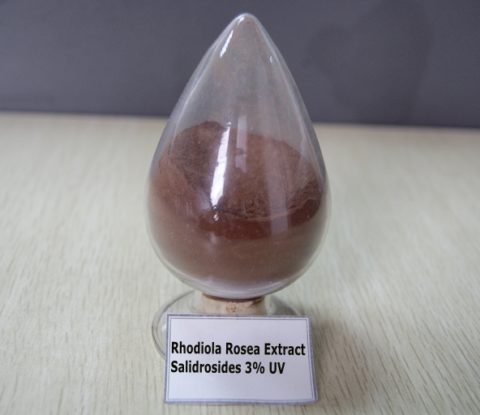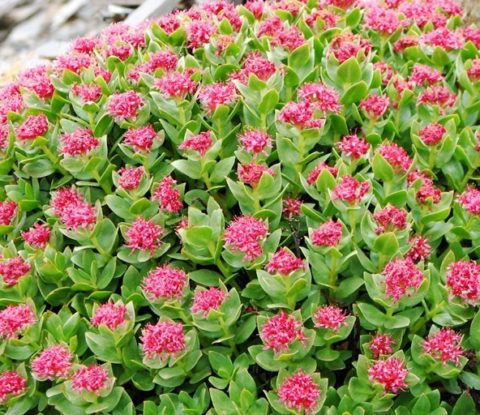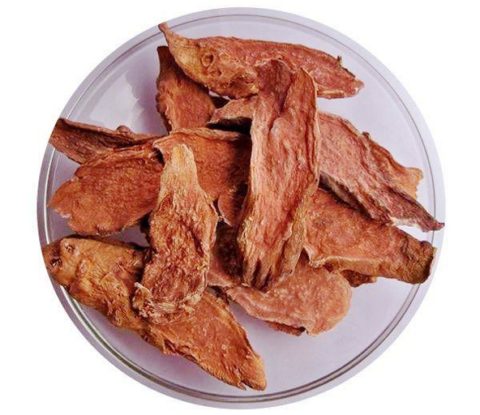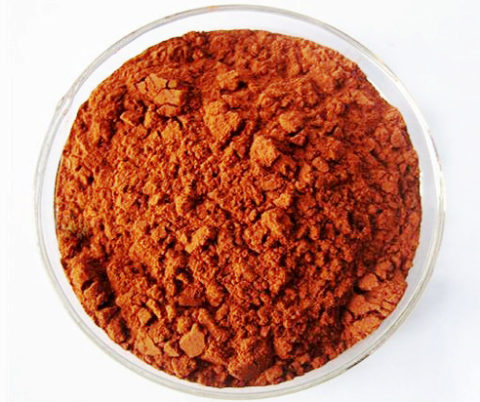
Rhodiola Rosea Extract
【Latin Name】: Rhodiola Rosea L
【Common Names】: Golden root , roseroot , arctic root , SHR-5 , rhodaxon
【Active Ingredient】:
Rosavins
CAS Number: 84954-92-7
Molecular Formula : C20H28O10
Molecular Weight: 428.44
Salidrosides
CAS Number: 4773-96-0
Molecular Formula : C14H20O18
Molecular Weight: 300.304
【Specification】:
Rosavins(Rosarin, Rosavin, Rovin) 1%-5% HPLC
Salidroside 1%-5% HPLC
10:1, 20:1TLC
【Test method】:HPLC&UV&TLC
【Appearance】: Red Brownish Powder
【Particle size】: 95% pass 80 mesh
Brief Introduction
Rhodiola Rosea (of the family Crassulaceae; henceforth Rhodiola) is a herb traditionally used as an Adaptogen compound and is synonymous with common names such as Arctic root, Rose root/Rosenroot, Orpin Rose, or Golden root. The adaptogenic effects have traditionally been referred to as inducing a ‘nonspecific immunity’ and normalizing effect, and traditional usage seems to be localized to around Europe and sometimes spreading east into Asia (with usage reported in Mongolia and Siberia) and is commonly reported to have traditionally been used by scandinavian Vikings to preserve physical robustness (this may be speculative). It has extended far enough into Asia to be incorporated into Traditional Chinese Medicine (under the name Hong Jing Tian) where it is recommended to take 3-6g of the root daily for vitality and longevity.
Rhodiola is common to northern Europe and Russia at altitudes between 1000-5000m, and can be found on some North American coastlines. The main commercial source of Rhodiola appears to be Mountain Altai and in south region of foothill Altai, mainly in Ust-Kanski, Ust-Koksinski, Charishki regions. Rhodiola (rosea as the most common species) is a nordic/russian herb that has traditionally been used as a vitality enhancing and physical preserving agent. It has also sometimes been used for cognitive decline and the connection between cognition and physical fatigue.
Chemical Analysis
The root of rhodiola (main segment that is used medicinally) contains:
-Tyrosol, sometimes seen as one of the main bioactives, and its glucoside known as Salidroside (chemically p-hydroxyphenylethyl-O-ß-D-glucopyranoside and synonymous with Rhodioloside or Rhodosin) as the other main bioactive.
-The ‘Rosavins’ (Rosin, Rosarin, and Rosavin are the main rosavins. Other molecules that can possible be called rosavins include rosaridin, but this molecule is structurally different).
-Viridoside (structurally Salidroside that is methylated).
-Lotaustralin (Cyanogenic glycoside).
-Gossypetin (as 7-O-L-rhamnopyranoside) and Rhodioflavonoside (Gossypetin diglycoside).
-Benzyl-O-β-glycopyranoside.
-Procyanidins built off of EGCG (from Green Tea Catechins) at up to 35% of a 70% aqueous acetone extract by weight. Procyanidins appear to consist of up to 3.6-5.43% of the weight of the dry root dependeing on growing conditions which places it lower than grapes (7.8%) and sea buckthorn (8.14%) but higher than craetagus pinnatifida (2.7%).
-Small phenolics including gallic acid, cinnamic acid.
-β-sitosterol.
Indications of Rhodiola in TCM
Rhodiola is mainly found on rocky slopes at 3,500-5,000 meters (11,000-16,000 feet). The Chinese name hongjingtian refers to the red flowers of the stonecrop-the common name given in the West (hong = red, jingtian = view of heaven or heavenly view, probably referring to its growth on high altitude stone faces). This herb is in the family Crassulaceae, which yields a small number of genera of medicinal plants, mainly rhodiola and sedum. The root of the plant is used in the current medicinal applications. The outer peel of the root has a light golden color, so that the herb is sometimes referred to as golden root; the inside of the root is pink. There are several species of rhodiola collected, with the main ones being Rhodiola rosea and Rhodiola kirilowii; others are being investigated, including R. eoccinca, R. crentinii, R. krifida, and R. atropurpurea.
Tibetan rhodiola has become so popular in recent years that, according to a survey by the Tibet Institute of Biology, 10,000 tons of it are collected annually and six factories make products that have rhodiola as a key ingredient (or sole ingredient). Rather than relying on its traditional applications, rhodiola is presented as a health product of general benefit, described as an adaptogen.
The concept of an adaptogen has been attributed to the Russian pharmacologist N.V. Lazarev from his work during the period 1958-1959. Basically, he defined an adaptogen as a substance that has no toxicity or side effects at normal dosages and that non-specifically increases the resistance to disease and to physical and chemical stresses. Put another way, use of an adaptogenic herb will safely assist the body in maintaining its homeostatic balance and recovering from the effects of adverse weather, emotions, and disease influences. The leading advocates of developing natural resources as adaptogens were the Russian researchers I.I. Brekhman and I.V. Dardymov. They reviewed the status of research into adaptogenic agents in the seminal article “New substances of plant origin which increase non-specific resistance,” published in 1969.
The leading adaptogens identified at that time were eleutherococcus (Eleutherococcus senticosus), ginseng (Panax ginseng), rhaponticum (Rhaponticum carthamoides), and rhodiola (Rhodiola rosea). The Russians went on to develop eleutherococcus (usually simplified to eleuthero) as a major health product, used locally and exported to Western countries. The Chinese developed their own resources of this herb (which grows in abundance in northeast China), eventually becoming the world’s main supplier. Ginseng had long been used in the Orient and revered as a health tonic; the Koreans developed the world market for this herb, promoting research into its pharmacology and clinical effects and cultivating huge quantities of the roots. China and the U.S. (providing an American species, P. quinquefolium) eventually became major suppliers as well. Rhaponticum is still being investigated in China and Russia; it is mainly studied in relation to antioxidant activity, but is also reputed to improve circulation and mental acuity. Rhodiola has been researched in Russia and China and has become a common health food product which has been promoted in the West in recent years. The development of rhodiola as an adaptogen represents one aspect of Chinese efforts to promote Tibetan medicine.
As an adaptogen, rhodiola is considered to be like ginseng (renshen) and eleuthero (ciwujia) in terms of effects and applications; adaptogens from numerous different plant species have the same basic actions. Modern promoters of rhodiola have dubbed the herb “Tibetan ginseng.” Though some herbalists object to this off hand use of the term ginseng (similarly, ashwaganda is called Indian ginseng, eleuthero is called Siberian ginseng or eleuthero ginseng), it may well represent the current intended use of the herb for consumers who are already familiar with ginseng as a general health tonic. One of the adaptogenic applications of rhodiola that has received considerable research attention recently is for aiding adaptation to high altitudes, thus, as a preventive and treatment for mountain sickness.
Pharmacological Actions
1. Adaptogen Tonic, Helps Reduce Stress and Anxiety
Rhodiola benefits the body as an adaptogenic substance with a normalizing effect on the endocrine and immune functions, regulating either the underactivity or hyperfunctioning of the organs and glands. Adaptogens, like rhodiola as well as many of the Ayurvedic rasayana herbs and major Chinese tonics, like fo-ti, ashwagandha, astragalus, tulsi and ginseng, help us to “adapt” and naturally increase our resistance to everyday stress factors and chronic anxiety.
Rhodiola, or hong jing tian in Chinese medicine, is known to replenish Chi (Qi), clear the lungs, nourish the heart, fortify the spleen, boost mental acuity and has calming effects on the central nervous system. It is an often recommended herbal supplement for those who suffer from general weakness, adrenal exhaustion or are recovering from paralysis caused by a stroke.
Since the 1960’s, there have been many published research studies investigating the effects of rhodiola benefits as an adaptogen. One of the leading Russian researchers was Dr. Zakir Ramazanov, president of the National Biosciences Corporation. Ramazanov was one of the first to introduce Siberian rhodiola to the Western marketplace and was a major contributor to the book entitled “The Rhodiola Revolution.”
The protective effects of Rhodiola rosea are believed to be associated with an increase in the levels of opioid peptides. Opioid peptides are short sequences of amino acids that attach to opioid receptors in the brain. Having an opiate-like effect, they play an important role in bodily response to pain, trauma and stress.
Other components involved in rhodiola’s restorative effects on the adrenal system are the active salidroside compounds that act as an anxiolytic to inhibit anxiety.
1).Reduces the “Stress Hormone” Cortisol
Rhodiola benefits the body as one of the best anti-aging herbs by relieving the impact of stress and the damaging consequences it can have on the biological systems over an extended period of time. Cortisol, known as the “stress hormone”, is the body’s corticosteroid hormonal response to stress and is secreted by the adrenal glands. When we experience constant physical and emotional stress, excessive amounts of cortisol can not only have an adverse effect on the nervous system, but also metabolic and cardiovascular functions.
Along with, of course, a health promoting diet, regular exercise and relaxation techniques, rhodiola supplementation can be additionally helpful for maintaining healthy cortisol levels by inhibiting unnecessary cortisol production, which can impede mental capacity and clear thinking. According to a 2009 double-blind study examining the effects of Rhodiola roseain the treatment of subjects with stress-related fatigue, it was confirmed that “Post-treatment cortisol responses to awakening stress were significantly different in the treatment group compared with the control group. It is concluded that repeated administration of R. rosea extract exerts an anti-fatigue effect that increases mental performance, particularly the ability to concentrate, and decreases cortisol response to awakening stress in burnout patients with fatigue syndrome.”
2).Cardioprotective Effects on Heart
Rhodiola has been shown to have cardioprotective effects on the heart. In one study examining the effects of stress-induced cardiac damage it was established that “the antistressor and cardioprotective effects of Rhodiola rosea are associated with limited adrenergic effect on the heart.” In addition, as we mentioned above, these protective effects are also associated with an increase in the levels of opioid peptides.
2. Helpful as a Brain Tonic and Natural Antidepressant
Rhodiola benefits also promote monoamine neurotransmitter activity, enhancing levels of serotonin, dopamine and norepinephrine in the brain which helps to uplift mood. Monoamines regulate cognitive processes and are known to help in the treatment of psychiatric disorders, including depression, anxiety and schizophrenia.
It is helpful for increasing our ability to analyze, evaluate, plan as well as remember and is a top tonic root tea or extract for those who work long hours behind a computer screen or at a desk, improving one’s capacity to concentrate and focus. It has often been used in Tibet as an herbal adjunct to meditation as it allows for focused mental states and also improves respiration. Two active ingredients found in Rhodiola rosea root are the compounds salidroside and rosavin. These are the primary elements believed to be responsible for its actions as a natural antidepressant and anxiety reliever.
In a 2007 study published in Phytotherapy Research entitled “Adaptogenic and Central Nervous System Effects of Single Doses of 3% Rosavin and 1% Salidroside Rhodiola rosea L. Extract”, the results showed that “R. rosea extract significantly induced antidepressant-like, adaptogenic, anxiolytic-like and stimulating effects in mice.”
3. Rhodiola Benefits for Physical Endurance Activities
Rhodiola benefits as an energizing tonic, like schizandra and cordyceps, and can be of particular use as an herbal supplement to those involved in regular physical workouts, athletic activities or professional sports. Helping to enhance oxygen utilization and physical endurance as well as decrease recovery time after exercise, rhodiola has been shown in various studies to improve resistance to high intensity exercise and physical exertion. It is often an ingredient in energizing herbal formulas along with other energy adaptogens like astragalus, ashwagandha and ginseng. These herbs work together for overall increased effectiveness.
According to a study published in The Journal of Sports Medicine and Physical Fitness, “Rhodiola rosea supplementation is able to reduce both lactate levels and parameters of skeletal muscle damage after an exhaustive exercise session.” Moreover, rhodiola supplementation was documented in the same study to improve fatty acid consumption and may also help to increase the body’s adaptogenic ability for physical exercise. In other research documented in the International Journal of Sports Nutrition and Exercise Metabolism it states that, “Acute Rhodiola rosea intake can improve endurance exercise capacity in young healthy volunteers.”








